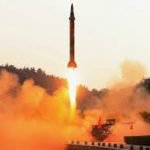DRDO test fires Naval Version of BRAHMOS missile successfully
On October 18, 2020, the Defence Research Development Organization test fired the naval version BRAHMOS missile from INS Chennai successfully. The missile was test fired from an indigenously built stealth destroyer INS Chennai. The missile hit a target in Arabian Sea
Highlights
BRAHMOS is a supersonic missile. It was jointly developed by India and Russia.
Classification of Missiles
The major classification of the missiles is Cruise Missiles and Ballistic Missiles
Ballistic missiles
The Ballistic Missiles are those missiles that have a ballistic trajectory. The currently operational ballistic missiles in the Indian Defence Systems are Prithvi I, Agni I, Prithvi II, Agni II and Dhanush.
Cruise Missiles
Cruise Missiles are those missiles that are self-propelled till impact. They use jet engine technology and fly within the atmosphere.
The Cruise missiles can be categorised based on their speed, range, size and whether launched from air, land or surface ship or submarine.
Speed
Based on the speeds, the missiles are classified as follows
- Hypersonic cruise missile
- Subsonic Cruise Missile
- Supersonic Cruise Missile
The Hypersonic Cruise missile travels at a speed of more than 5 Mach. Supersonic missiles travel at a speed of 2 to 3 Mach. The subsonic missiles travel at a speed of 0.8 mach.
Launch mode
The missiles are classified as follows based on their launch mode
Surface to surface missile
These missiles have a guided projectile Anda launched from a a vehicle mounted or trailer mounted or handheld or fixed installation. They are powered by a rocket motor or explosive charges.
Surface to air missiles
They are designed for launch from ground full stop there destroyed aerial targets such as helicopters aircraft or even ballistic missiles. They are generally called the air defence systems as they are generally involved in aerial attack.
Surface to sea missiles
These missiles are launched from land to destroy ships in the sea as targets.
Air to air missiles
These missiles are launched from aircraft to destroy the enemy aircraft.
The Other types are air to surface missile, sea to sea missile, anti tank missile and sea to surface missile.
Range
The missiles are classified based on their range as follows
- Short range missile
- Medium range missile
- Intercontinental ballistic missile
- Intermediate range missile
Propulsion
The missiles are classified as follows based on their proportion
Solid propulsion
Generally aluminium powder is used as solid propulsion fuel. They reach high speeds very quickly.
Liquid propulsion
The liquid propulsion Technology uses liquid as fuel. Generally, hydrocarbons are used as liquid propulsion fuels. However, storage of liquid propulsion fuel in the missiles is difficult. The impulse given by liquid propulsion fuel is higher than that of the solid propulsion fuel.
Hybrid propulsion
The two stages of hybrid propulsion are solid propulsion and liquid propulsion.
Ramjet
It does not have turbines. Rather the compression of air in the missiles is achieved through to forward speed of the missiles. Therefore, the Missile should travel at Supersonic speeds for the air to enter inside. The fuel is injected and ignited. The heat produced from the ignition expands the gases in the air and the combustion accelerates the Missile to higher velocities.
Scramjet
It is Supersonic combustion ramjet. Here hydrogen is used as fuel.
Cryogenic
These missiles use liquefied gases stored at very low temperature as fuel. Liquid hydrogen is used as fuel mostly.
Based on Warhead the missiles are classified as conventional Warhead and strategic Warhead.
Based on guidance system the missiles are classified as follows
- wire guidance
- command guidance
- Terrain comparison guidance
- Terrestrial guidance
- inertial guidance
- beam Rider guidance
- laser guidance
- radio frequency and GPS guidance.
Month: Current Affairs - October, 2020


